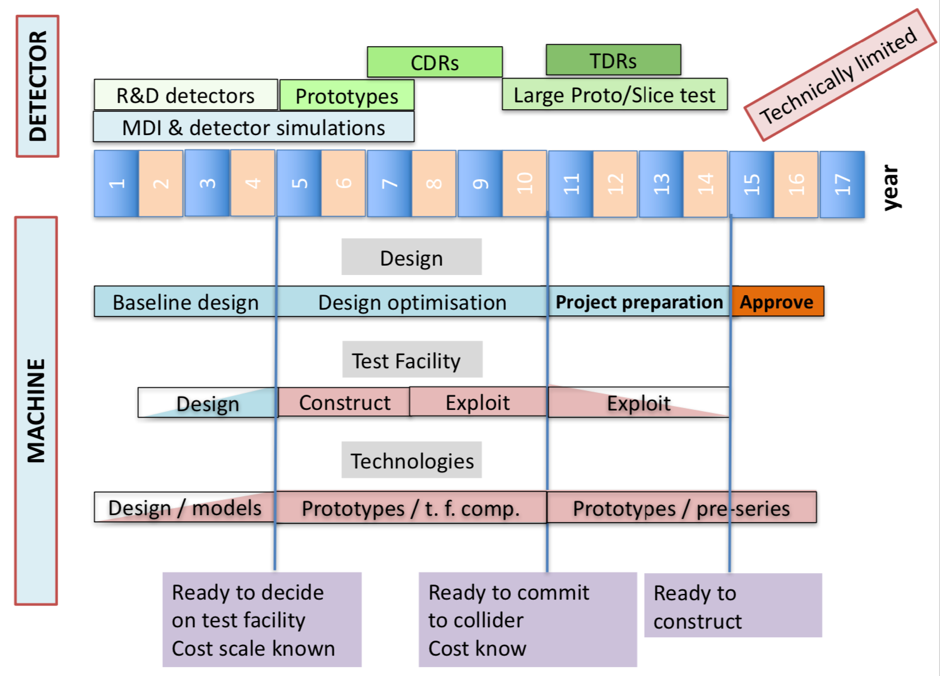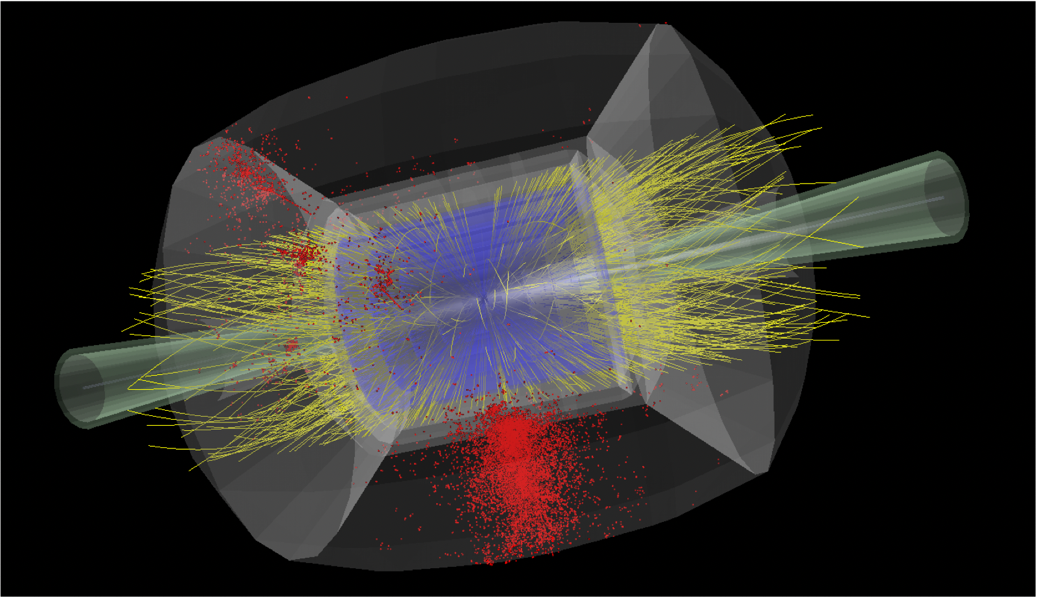A muon collider would zoom in on a narrow region of energy to uncover the physics phenomena that the LHC can't reveal on its own. It would provide a clear, unobstructed view of the subatomic world.
In the framework of the European Strategy Update on Particle Physics, a working group had been appointed by the CERN Directorate in September 2017 to review the status of muon collider activities. The group found that the muon collider is a very promising concept to reach high energies with high luminosities. Important R&D remains to be carried out but no major obstacle has been identified. The results are documented in a publication: “Muon Colliders” arXiv:1901.06150, submitted last December as an Input Document to the EPPSU.
In light of the positive evaluation, the main recommendations at the time were to set-up an international collaboration that will organize the effort on the development of both accelerators and detector while also defining the roadmap towards the next Strategy update. The collaboration should carry out a concrete R&D programme and produce a first Conceptual Design Report for a muon collider.
Since then the group has been acting de facto as a seed to revive international efforts to further explore the physics case and to start develop an R&D programme. The muon collider would be a unique lepton collider facility at the high-energy frontier.
Despite their attractive physics potential, muon colliders still represent significant challenges (both on the machine and the detector side) that call for a well-coordinated R&D effort. The main challenges of a muon collider design arise from the short muon lifetime, which is 2.2 μs at rest. Demanding technologies and innovative concepts are required to rapidly produce, accelerate and collide the dense muon bunches that are required to reach high luminosity. The decay of the muons and the produced secondaries also pose challenges for the accelerator complex and the detectors.
A preparatory meeting was held at CERN on April 10-11, before the Granada Open Symposium (Indico Link). This workshop attracted the interest of about 50 participants discussing the physics benchmarks, the detector simulation, machine design and the technology issues towards a required R&D plan. A strategy plan with a possible timeline to reach the construction phase of such a challenging facility was elaborated, as it appears in the Physics Briefing Book (arXiv:1910.11775v1).

As we are entering the closing phase of the EPPSU, a workshop was held at CERN on October 9-11 (Indico Link), bringing together more than 80 participants. The goal was to better coordinate the renewed efforts on future studies for a muon collider facility and address the new ideas and results achieved on the main areas where work is in progress: physics, detector and machine.
Ongoing work was reported on many physical and technical aspects. In addition, several teams from different countries reported on their past efforts and on their interest for new developments on muon-beams and Muon-Colliders. Discussions started to identify feasibility issues and possible synergies towards a feasible R&D plan, to start concrete actions to better organize the future steps and address priorities on key issues.
This workshop was the ideal environment to widen the international effort and start launching a proto-collaboration to address the most challenging and crucial items of the field. With the same purpose, a proposal to support and enlarge the European and International community working on muon colliders has been submitted to the next European Innovation Pilot project call INFRAINNOV-04-2020. The MUST - MUon colliders STrategy network – aims to organize the effort to design a muon collider facility and to get together the community to perform the required R&D.
So far two main muon collider concepts have been developed and proposed: in one the muons are generated using protons (MAP) while in the other using positrons (LEMMA).
As discussed during the workshop, careful studies have been done by the US Muon Accelerator Program (MAP) (see also:https://iopscience.iop.org/journal/1748-0221/page/extraproc46) launched in 2011 and terminated in 2014. The program focused on the development of high intensity muon accelerator technology for an advanced neutrino source, the "neutrino factory," as well as a potential future lepton collider. The MAP research efforts were devoted to verifying the feasibility of the key technology elements required for such machines based on tertiary production of muons from a high power proton driver. In this context, a minimum set of performance parameters for each stage of the accelerator chain were defined - i.e., for the proton driver, the front end (including a MW-class target operating in a solenoid capture magnet, decay channel, buncher and phase rotator sections), the cooling channel required to reduce the initial 6D-beam emittance by about 6 orders of magnitude within the lifetime of the muon beams, acceleration to the desired operating energy, and finally the storage rings for neutrino factory or muon collider storage applications.
The novel scheme based on muon pairs production from a positron beam of about 45 GeV impinging on the electrons of a target, Low Emittance Muon Accelerator (LEMMA), requires to be studied in detail to demonstrate its feasibility. This method allows to produce boosted (produced at 22 GeV) lower emittance beams with, in principle, no need to cool them. The main drawback is the low production cross section that will limit the muon bunch intensity. This requires the conception of an artful solution to accumulate bunches of suitable intensity (109). This challenging and innovative scheme still needs a full end-to-end design study of the whole complex, to prove its full feasibleness, as described in a recent paper (arXiv:1905.05747). A solid R&D programme to increase the muon beam quality as well as the current, and consequently the final luminosity, must be studied and put in place.
A muon collider represents the only elementary particle collider that can reach very high center-of-mass energies and luminosities. This is the result of the low level of beamstrahlung and synchrotron radiation compared to linear or circular electron-positron colliders. Moreover, its energy reach make muon collider competitive to proton-proton colliders for direct searches of new heavy particles. Furthermore, thanks to the fact that muons are elementary particles, physics measurements are not limited by the PDF uncertainties present at hadron collisions allowing for high-precision measurements. As an example, a muon collider with a center-of-mass energy of 10 TeV or higher and an instantaneous luminosity of the order of 1035cm2s-1, could allow to produce enough double and triple Higgs boson events to measure directly the trilinear and quadrilinear self-couplings, enabling an accurate reconstruction of the shape of the Higgs boson potential.
One session of the workshop was dedicated to the discussion of the beam-induced background effects on the detector and on the strategies to mitigate them. The stream of secondary and tertiary particles, from the muon decays, arriving to the interaction region poses a serious issue on the detector performance and, therefore, on the physics measurements. Without a specifically designed shielding, the occupancy in the tracking system and in the first layers of the calorimeter will be unacceptable high. For the first time, it was proved that the beam-induced background can be managed to exploit the unprecedented physics capabilities of such a machine.
The MAP collaboration has proposed a pair of cone-shaped tungsten shields in the vicinity of the interaction point as the primary means of suppressing this beam-induced background. The cone opening angle is optimized depending on the beam energy and interaction region lattice. The detailed study of the beam-induced background at a muon collider with the center-of-mass energy of 1.5 TeV, shows that these particles have on average low momentum compared to the hard processes of interest, and they are not synchronized with the beam crossing. Thus, the use of novel detector technologies with state-of-the-art timing resolution allows to reduce the detector occupancy to a manageable level providing a sufficient track (90% efficiency) and jet reconstruction (60% efficiency) performance. The full simulation in these conditions allowed to demonstrates that the Higgs boson decays to b quarks can be reconstructed despite the harsh environment as the event in figure demonstrates. The two b-jets are identifiable (red dots) among the beam-induced background. Significant improvements are expected from the application of advanced object-reconstruction and analysis techniques.

A potential workplan has been defined, based on the proposed timeline:
- four years: baseline design established and cost scale of the project identified. A test facility to address the challenges that this baseline has to be designed.
- six years: construct and operate a test facility.
- four years: optimise design and project cost to launch a technical design
It appears reasonable to construct a muon collider in energy stages. A potential first stage could operate at a 3 TeV centre-of-mass energy. Such a facility could be implemented at CERN and reuse existing infrastructure. It may in particular be possible to use the LHC tunnel to house the largest part of the complex, the muon accelerator. A second energy stage could be 14 TeV. This facility is more demanding and would profit from the experience of the implementation of the first stage. Lower energies could also be explored. However, the strength of the muon collider appears more pronounced at high energies. It is the only concept in which the luminosity per beam power can naturally scale up with energy. In contrast, in linear colliders the luminosity per beam power is in first order independent of the collision energy.
An on-going international effort is now preparing a plan to address the critical key challenges, required to timely start a focused R&D programme. A preliminary R&D list will be compiled by the end of the year. A strong recommendation for a vigorous R&D programme on Muon Colliders will be key to start the international collaboration to develop this unique opportunity for High Energy Physics.


